The card is intended for my brother and his wife and their new baby. One of the pages will feature a mommy meerkat holding an infant.
I'm imagining more than one page, but at this point I'm not sure how many. I'm imagining a meerkat story, of sorts, but I don't know how far I intend to take it. Depending on difficulty, I might abandon that idea and just mail whatever I end up with at the time I burn out on the project.
This is vaguely what the first page will look like. A single meerkat.
The idea here is for the shoulders, neck, and head to lift forward and up above the top of the card, and for the legs to extend beyond the bottom of the card, thus appearing to jump out beyond the dimensions of the pages. That's dramatic, and I think it's funny.
This shows I can create a rounded head and face and still have it all fold flatly.
Its arms start out in a bent position above the head and flip down, straightening at the elbow to rest dangling in front of its body as meerkats tend to do. The one above is wearing a robe. That looks like it's not going to work out, so I think I'll settle for a naked meerkat, which isn't as amusing, possibly drawn onto the background or possibly with another bulging mechanism for the body. Here, the legs are cut to get them to fit inside the card when it's folded. You can see its legs are too short. That tells me to move up that mechanism and to extend its height, that way the leverage will be greater and more dramatic. But I must balance it out, meerkats have rather short legs. I might take some liberty with all that, for the sake of pop-uppery.
The legs:
You know how muscles are attached to two bones to create movement? This is like that. Except they're not bones, and they're not muscles. They're paper, and movement depends on the transfer of force, not on independent volition. Come to think of it, this isn't anything at all like muscles. Bad analogy there. Sorry.
Here's the deal. Each arm is really two arms attached on separate hinges. The components of the arms are hinged at the shoulder and at the elbow. The two hinges at the shoulder are the exact distance from each other as the hinges at the elbow. Here's the trick: because the hinges are attached to another hinge that moves with the card, the arm is folded and tucked when the card is closed, extended when the card is opened. You can see everything is executed at nice 90˚ and 45˚ angles, which makes calculations straightforward and makes the result of movement more predictable and much less mysterious.
You'll notice:
• The arms are provided hinges. Could have planned that better by including them with the cutout arms.
• The first hairy arms with hands are attached onto the shoulders above the fold that is created by the addition of the shoulder/head mechanism (and so also directly above the new additional tiny hinge mechanism placed directly above that first shoulder fold.)
• The arm hinge is trimmed so it doesn't extend beyond the shoulder fold and interfere with the hinge below it.
Alrighty then, on with the card.
Switch from ordinary card stock purchased in vast quantity to 157 LB Bristol purchased in distressingly thin tablets of 20 pages each. I do wish they would sell this stuff in bulk so I could go through it with undisciplined abandon. As it is, I'm forced to be miserly about it, and that makes me sad.
Started with the legs. Having practiced, it was a snap. Still, I made a stupid mistake. Forgot to cut the ends of the posts at the same angle as they're attached to the card. Had to fix that, otherwise, the legs wouldn't fold properly. The fix involved additional hinges instead of built-in hinges. After the legs were attached, I trimmed the posts to help them disappear from sight and to avoid the whole thing appearing bulky or overly architectural.
Shaped the head from one go. The head came out looking a little bit like a mouse which caused me to consider making a few more heads then picking the best one but then I thought, "You know, these meerkats do all look a little different from each other. Just leave it." The ears are poorly positioned near the top. They shold be on the sides like human ears except funnier.
The head stuck out beyond the card when the card was folded closed so I chopped it off. It projected beyond the edge opposite the spine, not the top as you might imagine. Instead of just shortening the neck I lengthened it by first cutting the stub of a neck to a point then attaching a new neck segment glued with hinged tabs at a new angle straight upward, wrapping it around the point, which also provided a peak for the whole head to attach which was nice because now I didn't have to stretch the head out by force of the card flattening. This is arranged forward, or upward from the spine when the card is laying flat as if the meeerkat is sticking his head forward. When the cards folds closed, the mechanism the neck and head is mounted on causes the whole structure to curl inward toward the center of the card instead of straight up beyond the edge of the card. It's really neat-o. It totally looks like I planned it that way instead of it having been improvised, and this fills me with glee and wonder.
Added arm hinges. Twice. The first ones were too large and the angle was too broad, changed the full angle from 100° to 90°. This ripped the background and that's a shame. Almost caused me to start over but I think I can work around that little problem by drawing a background over it, or providing a new back. Depends on how lazy I'm feeling when the time comes.
The body is a tent. Kind of a flat tent. The sides are attached parallel to the central fold with two hinged tabs on each side. This allowed me to round the body pulling it in slightly at the waist. The layer that is the body need not lay flat when fully opened. It will still fold flat when closed. The ends are crimped to close the ends of the tent and to provide space for the head and the legs to fold into when the card is closed. The crimps are extended when the card is opened and the crimps are fully crimped when the card is closed. That is what creates the space for the head and legs to tuck coming in from opposite directions as the card closes. This took some trial and error to determine a workable length for the body and the depth of the crimp needed for the other parts to tuck into. The spaces remaining between the head and the body, and the leg assembly and the body is filled with background strokes imitating meerkat fur to visually unite the mechanisms.
Nice. The head tucks into the center of the card, the legs lift up into the center of the card, they both tuck into the crimps of the tented body, it springs back open to fully extended. With very little imagination it actually does resemble a meerkat. This will do for the first page.
Oh snap! I just now realized I need to make a tail. The tail totally makes it.
• The top arm's hinges run horizontal, parallel with the top of the card. Isn't that nice? Rarely are pop-up mechanisms this clearly conceptualized.
• A new folding surface, another hinge, is placed directly over the fold of the original shoulder piece, itself a folding hinged surface -- a hinge on top of a hinge, if you like, operating in opposite directions. (two, actually, one for each meerkat arm.) These hinged surfaces are located directly underneath the meerkat's hairy little arm.
• A new thinner mechanical arm is devised to be used as a pole to shove and to pull. It's attached at the shoulder underneath the real arm but passes through the arm and connects beyond the bend of the elbow (the exact distance elbow to hinge, as the distance between the two shoulder hinges.
• The two new thinner mechanical arms are attached to the new tiny hinged surfaces located underneath the meerkat arms. Glue covers only half the exposed area, which becomes folded.
• A slot is cut in the meerkat's hairy arm for the mechanical arm to slide through. So that the mechanical arm transfers from underneath the meerkat arm to above it.
• The mechanical arms are now no longer hidden. They're unsightly and must be disguised.
• The meerkat head is in the way so it's removed for now. This is a problem that must be worked out.
• The whole thing is sloppy but it works. A little more work needed to determine the exact length and placement of the elbows. Possibly vary the distances so they fold more smoothly without interfering with each other. Sturdier reinforced arms needed to ensure they open/close forcefully without bending and without help.
• Must be able to work with a meerkat head in place and extended forward. Possibly might require longer arms.
The arms:
Alrighty then, on with the card.
Switch from ordinary card stock purchased in vast quantity to 157 LB Bristol purchased in distressingly thin tablets of 20 pages each. I do wish they would sell this stuff in bulk so I could go through it with undisciplined abandon. As it is, I'm forced to be miserly about it, and that makes me sad.
Started with the legs. Having practiced, it was a snap. Still, I made a stupid mistake. Forgot to cut the ends of the posts at the same angle as they're attached to the card. Had to fix that, otherwise, the legs wouldn't fold properly. The fix involved additional hinges instead of built-in hinges. After the legs were attached, I trimmed the posts to help them disappear from sight and to avoid the whole thing appearing bulky or overly architectural.
Shaped the head from one go. The head came out looking a little bit like a mouse which caused me to consider making a few more heads then picking the best one but then I thought, "You know, these meerkats do all look a little different from each other. Just leave it." The ears are poorly positioned near the top. They shold be on the sides like human ears except funnier.
The head stuck out beyond the card when the card was folded closed so I chopped it off. It projected beyond the edge opposite the spine, not the top as you might imagine. Instead of just shortening the neck I lengthened it by first cutting the stub of a neck to a point then attaching a new neck segment glued with hinged tabs at a new angle straight upward, wrapping it around the point, which also provided a peak for the whole head to attach which was nice because now I didn't have to stretch the head out by force of the card flattening. This is arranged forward, or upward from the spine when the card is laying flat as if the meeerkat is sticking his head forward. When the cards folds closed, the mechanism the neck and head is mounted on causes the whole structure to curl inward toward the center of the card instead of straight up beyond the edge of the card. It's really neat-o. It totally looks like I planned it that way instead of it having been improvised, and this fills me with glee and wonder.
Added arm hinges. Twice. The first ones were too large and the angle was too broad, changed the full angle from 100° to 90°. This ripped the background and that's a shame. Almost caused me to start over but I think I can work around that little problem by drawing a background over it, or providing a new back. Depends on how lazy I'm feeling when the time comes.
The body is a tent. Kind of a flat tent. The sides are attached parallel to the central fold with two hinged tabs on each side. This allowed me to round the body pulling it in slightly at the waist. The layer that is the body need not lay flat when fully opened. It will still fold flat when closed. The ends are crimped to close the ends of the tent and to provide space for the head and the legs to fold into when the card is closed. The crimps are extended when the card is opened and the crimps are fully crimped when the card is closed. That is what creates the space for the head and legs to tuck coming in from opposite directions as the card closes. This took some trial and error to determine a workable length for the body and the depth of the crimp needed for the other parts to tuck into. The spaces remaining between the head and the body, and the leg assembly and the body is filled with background strokes imitating meerkat fur to visually unite the mechanisms.
Nice. The head tucks into the center of the card, the legs lift up into the center of the card, they both tuck into the crimps of the tented body, it springs back open to fully extended. With very little imagination it actually does resemble a meerkat. This will do for the first page.
Oh snap! I just now realized I need to make a tail. The tail totally makes it.

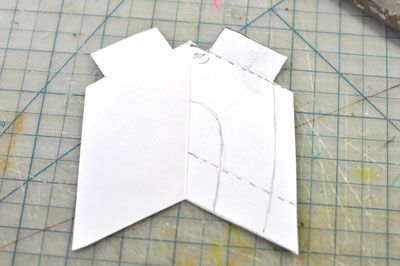

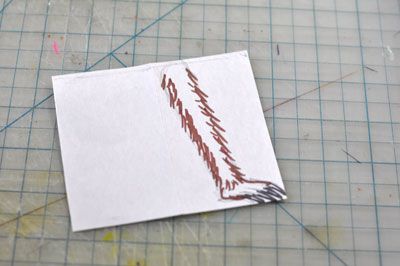


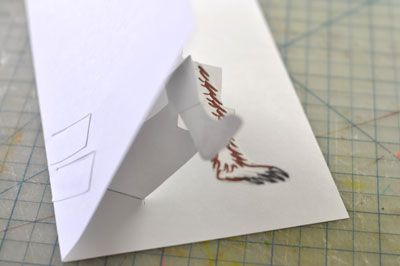
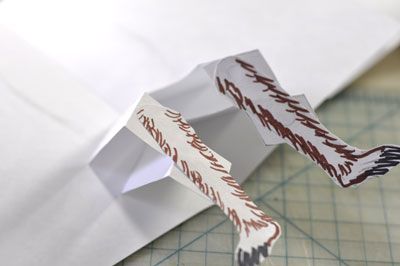
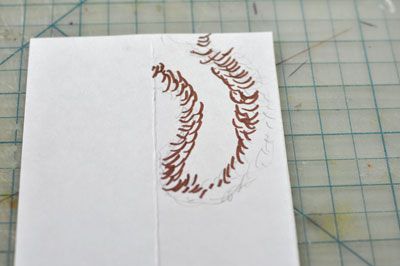

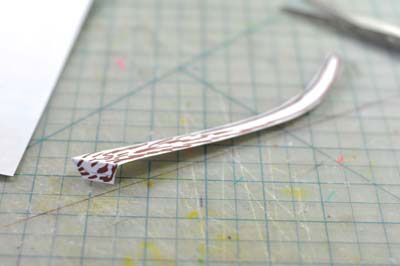

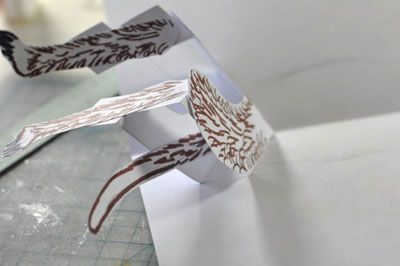

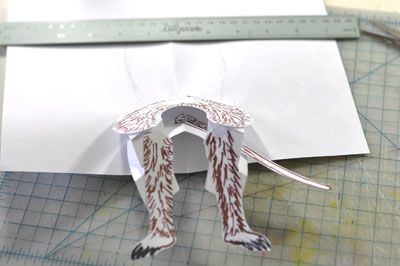


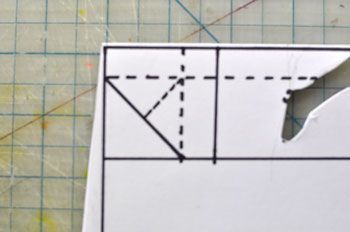




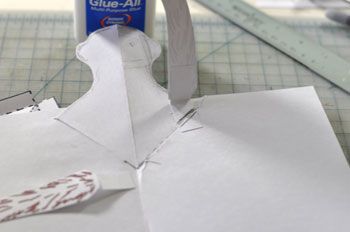
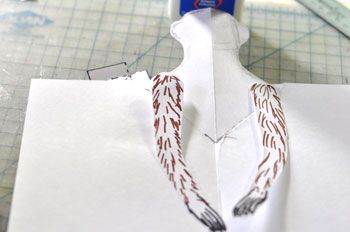


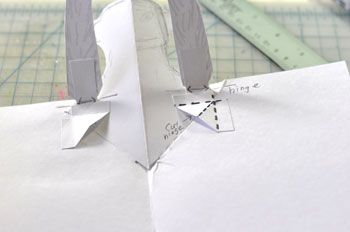




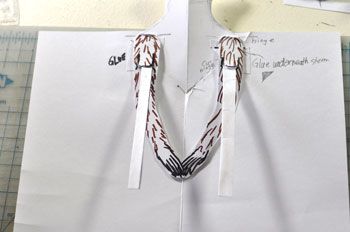
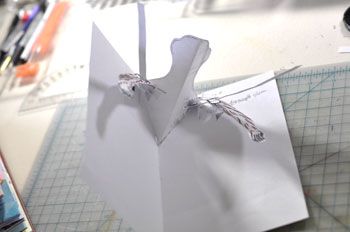

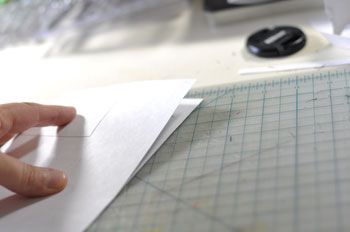



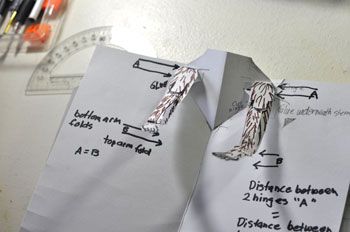
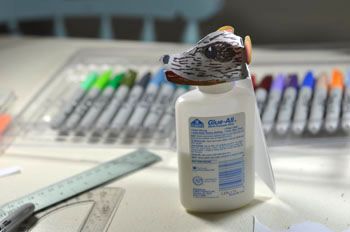
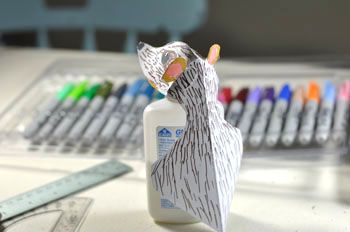





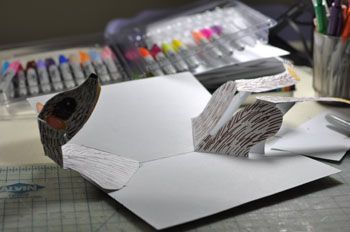
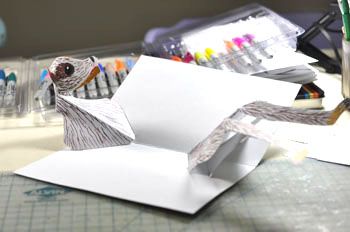


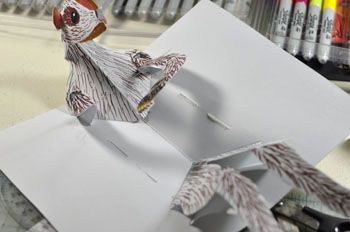

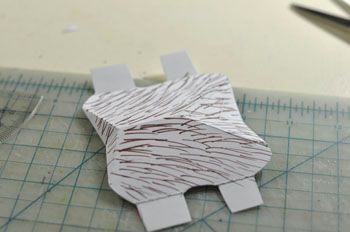
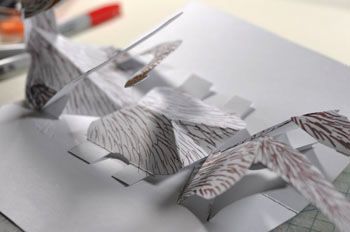



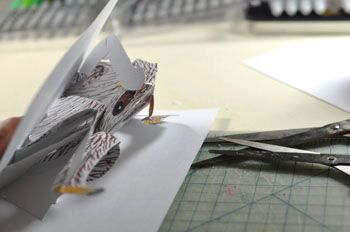


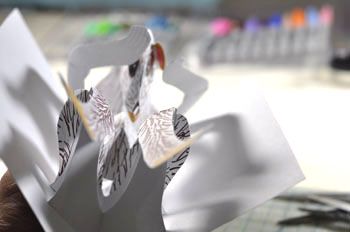
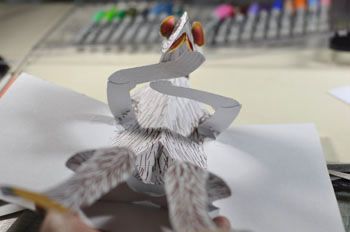
No comments:
Post a Comment